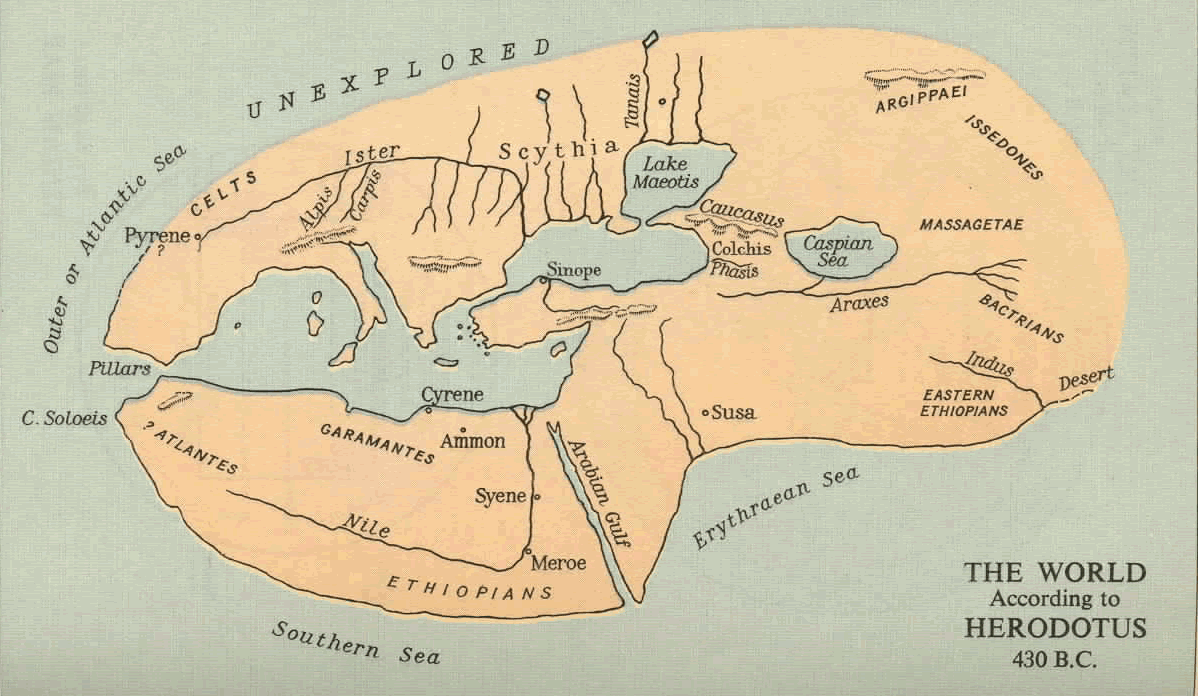
Map of the world as described by the Greek historian Herodotus (ca 484–425 B.C.)
| Instructor: | |
| Time/Location: | online! |
| Contact Info: |
Office: Cesar Chavez 410 |
OVERVIEWHistory 204 traces the political, social, literary and cultural history of Greece over roughly 2500 years: from the time of the Minoans (ca 2700 B.C.) to the fall of the Ptolemaic kingdom of Egypt (30 B.C.). We will explore our subject primarily through the texts of Greek prose writers and poets, as well as modern historians; but we will also employ archaeological remains, artwork and other types of material culture to obtain a well-rounded view of the ancient Greek world. |
GOALSBy the end of this course, you should be able to:
|
READINGSThe required text is as follows:
This book is free to read online via the University of Arizona Library. If you would like to buy a hard copy, you may of course do so, but not at the UA Bookstore, since the book has NOT been ordered for this class. There are also a number of additional readings for this course. These will be hyperlinked to this page or made available for download from the D2L site for HIST 204 as pdf files: see the "Readings" area of the "Content" section. To view/download them, you will need Adobe Acrobat Reader (free download available here). |
GRADINGGrading for the course will be based on the following breakdown:
|
OTHER (IMPORTANT!) COURSE POLICIES: READ CAREFULLY
|
VARIOUS UNIVERSITY POLICIES:
|
COURSE SCHEDULE AND DUE DATESWhat follows is a list of assignments for HIST 204. Since this is (for the most part) a self-paced online course, there is ***ONLY ONE DUE DATE/TIME PER SESSION.*** They are the following:
ALL of your work for the course MUST be submitted on D2L by the specified date/time in order for it to count towards your final grade for the course. Anything not submitted by this deadline will not be counted. Check this page often, as readings and assignments are subject to change. I will also (of course!) give you all a heads-up over email or on the course D2L page if a major shake-up is imminent. |
| Assignment | Subject/Details |
| 1 | Greece before Greeks; Egypt and the Ancient Near East VIEW (D2L): PowerPoints on Mediterranean geography, ancient Babylon and ancient EgyptREAD (D2L): Samuel Greengus, "Legal and Social Institutions of Ancient Mesopotamia" (pp469–484 of J.M. Sasson, ed., Civilizations of the Ancient Near East, vol. 1 [New York, 1995]);
David Lorton, "Legal and Social Institutions of Pharaonic Egypt" (pp345–362 of J.M. Sasson, ed., Civilizations of the Ancient Near East, vol. 1 [New York, 1995]) and complete reading worksheet #1 and D2L discussion #1 |
| 2 | Archaic Greece; the Worlds of Homer and Hesiod READ (textbook): Martin, Ancient Greece, chapter 4 (pp65–90) and take D2L quiz #2 ***You are now able to write Short Paper #1.*** |
3 |
Greece in the Seventh and Sixth Centuries READ (textbook): Martin, Ancient Greece, chapter 5 (pp91–120) and take D2L quiz #3 ***You are now able to write Short Paper #2.*** |
| 4 | The Persian Wars; Classical Greece (1) READ (textbook): Martin, Ancient Greece, chapters 6–7 (pp121–185) and take D2L quiz #4 |
| 5 | Classical Greece (2); the Peloponnesian Wars READ (textbook): Martin, Ancient Greece, chapter 8 (pp186–220) and take D2L quiz #5 |
| 6 | Greece in the Fourth Century READ (textbook): Martin, Ancient Greece, chapter 9 (pp221–252) and take D2L quiz #6 ***You are now able to write Short Paper #3.*** |
| 7 | Alexander the Great; the Hellenistic Period READ (textbook): Martin, Ancient Greece, chapter 10 and Epilogue (pp253–282) and take D2L quiz #7 |